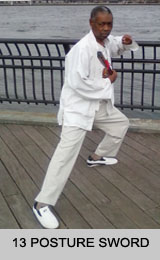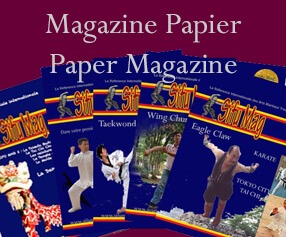
A Kowtow To The Boxers Of Old " Wu Yu Xiang's Taijiquan"
This article is based on Sun Jian Guo's book on the Taijiquan of Wu Yu Xiang (1812-1880), and some of it's components. In It are included 3 traditional fist forms, an excellent timetable of events, 2 postures from the practice of training logs similar to the shaolin poles, self defense applications, biographies of several important boxers and a short lineage chart at the end of the book. Also included is a DVD.
There are photos of Sun Jian Guo, student of Lin J in Fan (1920-1991) with the sword, knife, and staff and Also demonstrating Fa Jing (explosive power). Two of his student are posed to begin sparring with knives. These knives are shaped like one half of a spearhead on the dull side of the blade for hooking or catching weapons in combat. The author is also shown practicing staff with a Caucasian student in the mountains, and even Chen Xiao Wang from the Chen family makes an appearance on page 6.
The author has been frequently seen in Chinese martial arts magazines, has almost 100 listed students, and his teacher was a direct student of Li Yi Yu's (1832-1892).
The timetable of events as everything else, is written in Chinese, but not the years in which events take place from 1634-2011.
The 1st routine or form of Wu Yu Xiang was created by him in the year 1857, called the center or main form. In 1859 he created Pao Chui, 13 Posture Knife, and 13 Posture Sword.. Li Yi Yu the prized student of Yu Xiang, is the one actually credited with the creation of the 3rd form simply titled "Xiao Jar, in the year of 1862. Some comparisons of the forms are as follows, the 1st routine is quite long and the stances are large.
Li Yi Yu the prized student of Yu Xiang, is the one actually credited with the creation of the 3rd form simply titled "Xiao Jar, in the year of 1862. Some comparisons of the forms are as follows, the 1st routine is quite long and the stances are large.
The 2nd form has even larger stances than the first, while the 3rd form has only small stances. Each posture (or photo) is given a number, for example, the first routine numbers from 1-374, the second routine from 1-159, and the 3rd routine from 1-141.
There are no jumps or skips in the 3rd form, as there are in the first 2 forms. In form #1 posture 159, both feet leave the surface left hand extended forward with the right hand hidden by the body right foot higher than the left with the left toes pointing towards the surface leading up to the movement of striking the opponents groin. In posture 164-165 of the 1st form, there is the slapping of the right foot with the right hand also with both feet in the air.
The jumps In the 2nd routine of Wu Yu Xiang are very pronounced, and when turning the pages of the book, cause one to just stop and look. In posture # 64, the author (demonstrating all 3 forms) looks up in the air, lowers his body, opens the eyes wide, spreads both arms to his sides, before springing into the air into the direction of 9 o'clock (our view). Both hands are now at his left and right rear, similar to athletes giving each other a chest bump. From posture # 72 also in the second routine (Pao Chui) from a posture resembling the Yang family's "Crane Spreads Wings" weight mostly on the left foot with hands forming into fists, the hands switch and once again both feet leave the surface looking as if the author was blown from behind by a very strong wind. The 1st jump lands in a bow and arrow stance, while the 2nd jump lands in a horse stance.
The 2nd routine is pretty much its own form. Besides the opening and a few postures such as a large "Single Whip", it bears little resemblance at all to the 1st routine, although some postures are found in all 3 forms. Xiao Jar (the 3rd form) is a very short form and is comprised of some movements from the 1st and 2nd routines of Wu Yu Xiang.
It is probably the strangest looking of the 3 forms in terms of martial arts application, but one can see the connection with the Wu/Hao form of the future.
Returning to the timetable, there are connections of names that should be stated.
Li Qi Xuan (1835-1899) is recorded as studying a book written by Chen Ching Ping. In 1861, Li QI Xuan is credited with creating the 2 person staff sparring.
The lineage of Wu Yu Xiang branches off into 2 main factions, the main one from Li Yi Yu which continues to today, and the other from Li Qi Xuan which was very brief. Although the illustrated lineage ends with Hao WeiChien, Hao Yue Ru and Hao Shao Ru are discussed in the book with Hao Shao Ru listed as studying the Wu, Li, and Hao family's Taijiquan. Just to keep Chen Xiao Wang company on page 6, is the magical appearance of Chen Fa Kur's name connected with a type of breathing later in the book. 2 training pieces of training apparatus are a plank over a body of water, and training logs to practice stances on.
According to research, there is a fourth form not present in this book exceeding the difficulty of Cannon Fist (Pao Chui). There is a nice story about Wu Yu Xiang and Yang Lu Chan's eldest son whom he was teaching, but one article can not cover an entire system of Taijiquan.
Let us all kowtow at least in spirit to the lineage of Wu Yu Xiang, the Li and Hao family boxers, and also to Sun Jian Guo.
By Alan Sims
